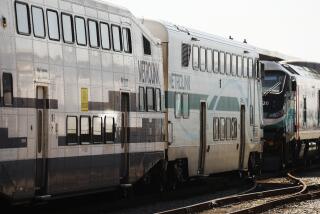When Joan Vowels died, the verdict was suicide. Her husband says it was not.
When pedestrians are struck by Metrolink trains, rail officials are often quick to declare them suicides or trespassers and slow to try to prevent others from the same fate.
Critics say that in many deaths, Metrolink performs only cursory investigations and fails to follow up with measures that could make it harder for people to reach the tracks.
For example, when Joan Vowels stepped into the path of a train in 1994, Metrolink released a statement saying she was a Bible-toting transient. The coroner ruled her death a suicide, relieving Metrolink of any obligation to report it to federal railroad authorities.
Both characterizations still rankle her husband, John Vowels. She had, in fact, been a resident of North Hollywood, a wife and mother and a teacher’s assistant at McClay Middle School in Sun Valley, two miles from the accident site. That morning as she got ready for work, he said, she was cheerfully planning a vacation with their kids.
“We kissed and said ‘I love you and I’ll see you this afternoon,’ ” he recalled.
But nothing bothers Vowels as much as the belief that his wife’s death might have been prevented had Metrolink installed a fence between its right-of-way across San Fernando Road and what was then a small hospital where he thinks she was heading.
More than two years ago Metrolink announced with great fanfare a “sealed corridor” plan for that area and the rest of its north San Fernando Valley right-of-way, where a high percentage of accidents occur, according to a Times database. The plan was the agency’s response to a crash in Glendale that killed 11 when a train hit an SUV parked on the track by a man bent on suicide.
Since then, the agency has installed stanchions and locked gates at street crossings to prevent cars from driving onto the right-of-way. But pedestrians can simply walk around the barricades, and even a car could get past them by jumping the curb, because much of the track has yet to be enclosed in fence. Fifteen years after she died, the stretch where Joan Vowels was killed is still easily accessible to anyone on foot.
“It drives me nuts,” Vowels said. “How much does it cost to put a damn fence up?”
Some of the most hazardous portions of Metrolink track have been fenced -- but not by Metrolink.
Nearly a decade ago, the city of San Fernando installed an iron fence along both sides of the track as part of a bike path project. Metrolink did not contribute to the $105,000 cost, said Dan Wall, the city’s engineer.
Los Angeles followed suit in 2006, extending the fence and bike path a little more than a mile into Sylmar.
Metrolink did not pay for any of the work or provide any support for the project, and rail officials weren’t happy about its proximity to the track, said Michelle Mowery, director of the city’s bike path program.
“Metrolink hasn’t been the easiest agency for us to work with,” Morry said.
In contrast, the Los Angeles County Metropolitan Transportation Authority -- a Metrolink sister agency operating its own light-rail and subway lines -- has virtually eliminated pedestrian deaths on its newest route, the Gold Line.
A fence encloses the entire right-of-way except the portion in Highland Park, where the proximity of frontage streets leaves too little space. There, train speed is restricted to 20 mph. In five years of operation, the Gold Line has had 19 accidents and one fatality, a suicide -- among the best safety records in the country.
More to Read
Sign up for Essential California
The most important California stories and recommendations in your inbox every morning.
You may occasionally receive promotional content from the Los Angeles Times.











